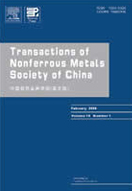Effect of partial recrystallization on microstructure andtensile properties of NiFeCoCrMn high-entropy alloy
(1. Key Laboratory of Metallurgical Equipment and Control Technology, Ministry of Education,Wuhan University of Science and Technology, Wuhan 430081, China;
2. Hubei Key Laboratory of Mechanical Transmission and Manufacturing Engineering, WuhanUniversity of Science and Technology, Wuhan 430081, China;
3. Precision Manufacturing Institute, Wuhan University of Science and Technology, Wuhan 430081, China;
4. State Key Laboratory of Materials Processing and Die & Mould Technology,School of Materials Science and Engineering, Huazhong University of Science and Technology, Wuhan 430074, China;
5. Southwest Technology and Engineering Research Institute, Chongqing 400039, China)
2. Hubei Key Laboratory of Mechanical Transmission and Manufacturing Engineering, WuhanUniversity of Science and Technology, Wuhan 430081, China;
3. Precision Manufacturing Institute, Wuhan University of Science and Technology, Wuhan 430081, China;
4. State Key Laboratory of Materials Processing and Die & Mould Technology,School of Materials Science and Engineering, Huazhong University of Science and Technology, Wuhan 430074, China;
5. Southwest Technology and Engineering Research Institute, Chongqing 400039, China)
Abstract: To obtain a balance between strength and ductility in NiFeCoCrMn high-entropy alloy, the degree of dislocation strengthening was tuned via partial recrystallization during traditional thermomechanical processing (cold rolling and recrystallization). The tensile properties in each state were then examined. Significant improvements in uniform elongation and work hardening rate, with decrease in yield strength and ultimate tensile strength, are associated with increase in the recrystallized fraction, i.e., reductions in the degree of strain hardening. In particular, recrystallized fractions of 37% and 74% are obtained by annealing at 650°C for 10 min and 15 min, respectively, which results in yield strengths of 1003 MPa and 742 MPa and uniform elongations of 4% and 24%, respectively. The strengthening is due to the unrecrystallized grains with a high density of dislocations, whereas the ductility benefits from the presence of recrystallized strain-free grains.
Key words: high-entropy alloy; partial recrystallization; microstructure; tensile property; strengthening mechanism

